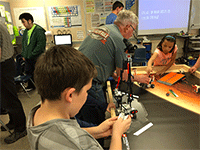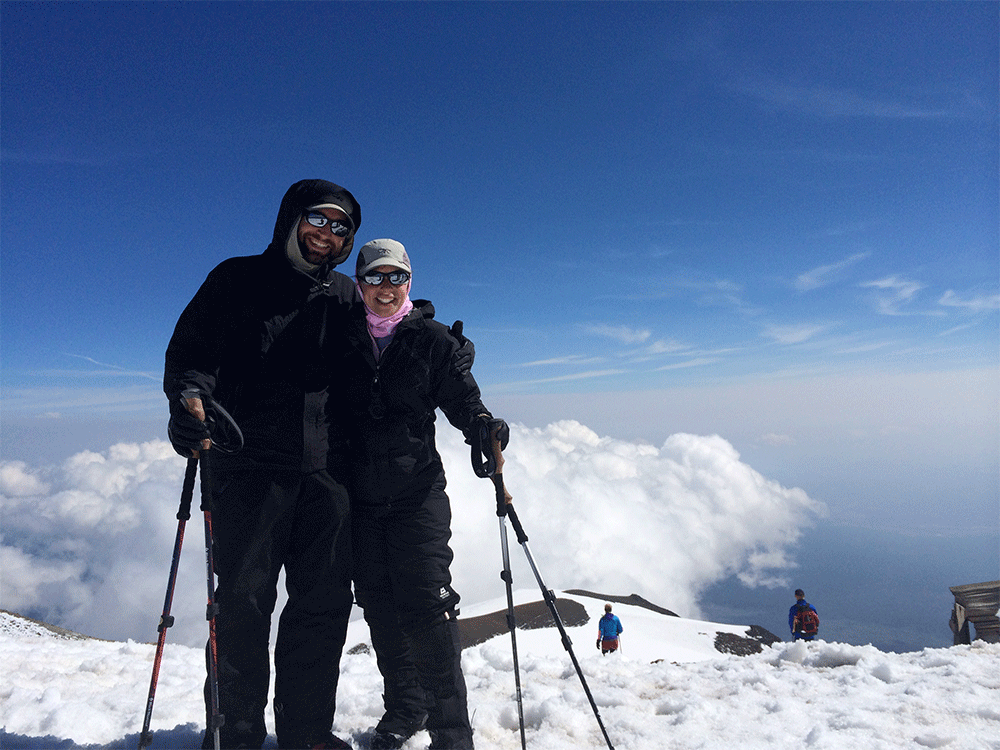AIAA Member Spotlight – July/August 2018 Written 2 August 2018
In This Section
AIAA Profiles AIAA Educator Associate Douglas Ferguson
By Lawrence Garrett, AIAA web editor

Influenced by his father’s passion for aerospace and his mother’s dedication to education, it is not surprising that Douglas Ferguson became a K-12 educator, a strong proponent of STEM K-12 programs, and an inspirational force to future generations looking to pursue a career in aerospace engineering.
Ferguson’s father, Stan, having interned at NASA before moving to Seattle to work as a Boeing engineer, was the primary catalyst for Ferguson becoming interested in all things aerospace. It wasn’t just him though, he noted, but also his two younger brothers, Bryce, who became an aerospace engineer, and Jeff, who became a Boeing procurement agent.
“As young children, all three brothers in my family marveled that dad worked on planes and rockets,” said Ferguson, noting that while growing up he and his brothers would spend hours reading through their father’s aviation books.

“We loved the pictures and read every detail we could about everything from blimps to flying cars to X-planes and the space shuttles,” he explained.
But it was his mother, Sherrie, said Ferguson, who later influenced him to take his love for aerospace and apply it to a career in education, where he’d have the ability to positively impact many young lives.
For the past ten years, Ferguson, who is an AIAA educator associate, has been a standout educator at Martin Sortun Elementary School in Kent, Washington, where he’s taught 4th, 5th, and 6th grades. He’s also served as a STEM Integration coach the past four years. Interestingly, Ferguson recently accepted a new position withAVID (an educational nonprofit that supports roughly two million students in public education) to develop STEM curriculum and professional development at a national level, so while Ferguson will remain a National Board-Certified Teacher, this coming fall will be the first time in his career that he’ll work outside the classroom.

Ferguson said that as an educator, the most rewarding aspect of the job is helping students “learn to believe in themselves” and “realize their true potential.” Nothing compares, he explained, to seeing “a spark and a sparkle in student’s eyes as they ‘get it,’” adding that the excitement generated from their learning achievement “is contagious.”
As evidence, Ferguson shared a story about a former student named Destiny who’d participated in his after-school STEM program. Coming to Ferguson for a robotics lesson, Destiny soon thereafter informed him “not to bother because she couldn’t do math and science.” But, as Ferguson noted, he allowed Destiny to participate in the program on her own terms and at her own speed.
Through a combination of “curiosity, care, encouragement” and “by believing in her,” Ferguson and others in the group eventually won Destiny over and she went on to become the group’s “star programmer,” and “top tutor for the younger students, and the most passionate advocate for the program.”
Ferguson noted that as Destiny began believing more in herself, her math and science scores began to rise dramatically, too.
“Seeing her transformation taught me a valuable lesson around what providing powerful STEM opportunities can do for students’ confidence,” said Ferguson.
Ferguson initially joined AIAA in 2011 to pursue the opportunities afforded to educator associates.
“I wanted to provide additional opportunities for my students, and I hoped to inspire some of them in their studies just like my early aerospace interest influenced me,” he explained.

Since joining, Ferguson has been active in the Institute, and has served as a member of the STEM K-12 Outreach Committee since January 2016. Ferguson said that he joined the committee because he appreciated the opportunities he’d received “and wanted to give back.”
As a member of the committee, Ferguson has participated in the micro-lessons group and has served as the group’s primary standards-alignment contributor, which allows him “to do most of the alignment in regard to which standards are cited for each micro-lesson.”
Ferguson encourages all AIAA educator associate members to become more involved in AIAA, via the various committees and opportunities available.
“AIAA is doing a lot of great work developing new outreach opportunities and really focusing on STEM education. These new efforts are a chance to help create something new and exciting, engage with professional engineers [who] can help connect with your work, and bring additional resources to students that they may not otherwise have access to in their current classroom setting,” said Ferguson.
Ferguson added that the AIAA STEM K-12 Outreach Committee is hard at work on strategies for attracting new students to the program. One of those strategies Ferguson is spearheading is micro-lessons, which he said are easy for all levels of K-12 teachers to engage in and utilize.
“By highlighting relevant standards, this becomes an easy, quick discussion activity, idea generator, and/or way to build awareness,” Ferguson said. He explained that raising awareness in younger students about the vast opportunities in the aerospace industry “helps spread the word.”

AIAA membership has positively impacted Ferguson’s career in a number of ways, he said, including through educational grants that have benefitted his classroom work and, more importantly, his students.
“The first year that I founded the robotics program at my school, I had multiple AIAA members that were able to volunteer and support the program,” he explained, noting that the program has enjoyed the participation of at least one other AIAA member every year since its inception.
Ferguson said being named the 2013 AIAA Pacific Northwest Section STEM teacher of the year was one of the most memorable moments of his teaching career, calling it “a wonderful honor.”
When attending the 2013 AIAA Pacific Northwest Section awards ceremony, Ferguson met and began to collaborate with another AIAA member who happens to be a Blue Origin engineer. Together, they partnered on a number of educational activities, including annual classroom visits by the engineer, followed by related aerospace lessons.
“Our partnership also grew into [one] between Blue Origin and my district,” Ferguson said. In fall 2016, with the help of some Boeing AIAA members, Ferguson successfully coordinated a visit by a Boeing team who worked with and mentored a total of 200 of his school’s 4th and 5th graders about aerospace-related work and engineering in general.
On a personal level, Ferguson noted, his involvement with AIAA has been “a great way to connect with my dad through his work in AIAA, and also to share stories and connect with my younger brothers.”
For today’s high school students who may be considering a career in aerospace engineering, Ferguson recommends pursuing all opportunities afforded by an AIAA student membership, from joining an AIAA-sponsored robotics team, for example, to taking advantage of mentoring opportunities with current engineers.
“Early opportunities open more opportunities and talking to as many people in the field as possible helps to provide a clear overview of the field,” Ferguson said, adding, “With all of this in mind, becoming a student member of AIAA is one of the best ways to access opportunities through AIAA.”
Looking ahead, Ferguson believes drone technology will have one of the largest and most immediate impacts on the aerospace industry.
“I think drone technology will continue to become more disruptive across more markets and in quite a few unexpected or unanticipated ways,” he said.
Noting that he’s already received an AIAA grant to analyze the potential role of educational drones at the K-6 level, Ferguson highlighted the fact that two other districts within his region will also begin using educational drones this coming school year.
“So, ironically, this technology is [already] starting to disrupt K-12 education,” Ferguson surmised.
In addition to drone technology, Ferguson also foresees commercial spaceflight as having a tremendous impact on the aerospace industry, across multiple markets, and that the advancement of propulsion systems will drive “some sort of economically viable space travel to near-Earth objects.”
Ferguson believes these advancements “will provide economies of scale that prove not only disruptive to the aerospace sector but society as well.”
Aside from his important work in the classroom, Ferguson enjoys exploring educational STEM tools and toys, programming projects, writing, and music, and loves to spend time with family and friends. Saying he’s “not the adventuresome” type, Ferguson noted that he’s usually attempting to keep up with his wife, Kimberly, and that following her on one of her adventures led to his marriage proposal.
“I actually proposed to her at one of the Mount Rainier base camps,” Ferguson shared.
AIAA salutes Douglas Ferguson for his passion for aerospace, indispensable contributions to STEM education and to the Institute, and wishes him all the best as he continues to serve as a key mentor for the next generation of aerospace engineers.
